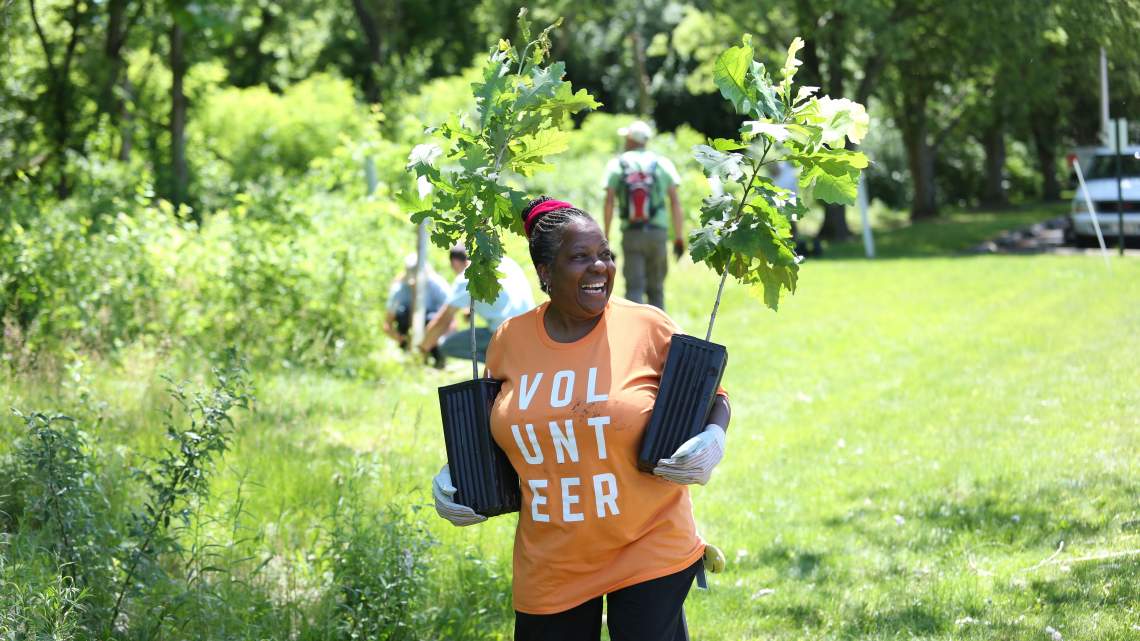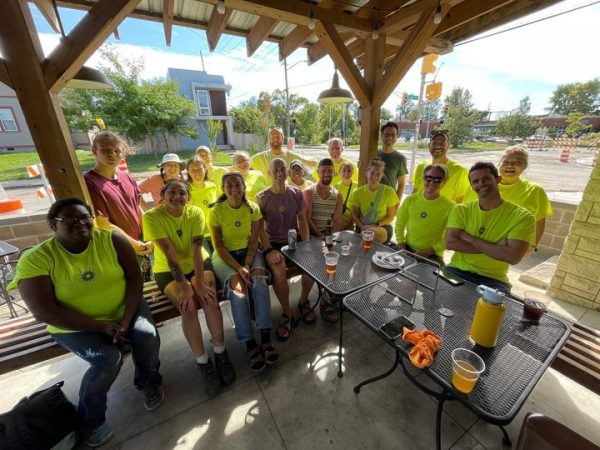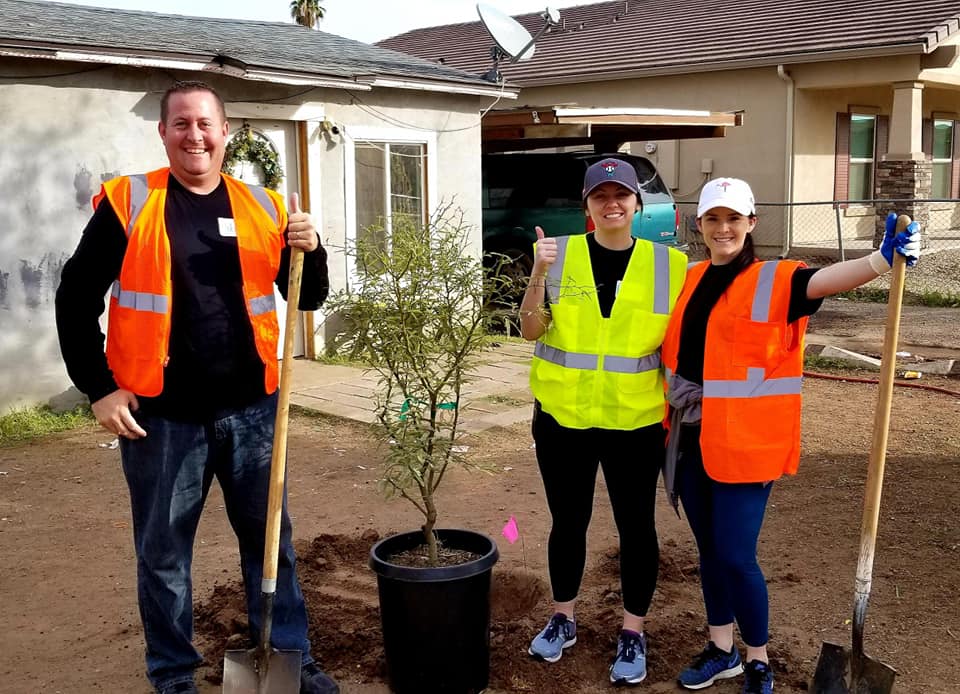Become a Volunteer
All across America, neighbors and coworkers are coming together to clean, green, and beautify communities. Working side by side, we restore waterways, public spaces, neighborhoods, and plant trees, shrubs, and flowers. Because everyone deserves to live in a beautiful community.
Find An Affiliate
Take Action Now
Affiliate Network
Individual Action Center
Partners for Change
5 Reasons Volunteering Makes America Beautiful
Did you know that volunteering is a uniquely American value? It’s a bigger part of our lives here than in many other countries around the world. And it makes this a pretty special place. Here are five reasons that volunteering makes America beautiful.
1. It’s been part of our history since day one.
Here’s a quick crash course for you on how volunteers have shaped America over the centuries.
Let’s start with the Revolutionary War — the seven years that brought America its independence. Who raised money to finance the war, boycotted British goods and joined in the fight? Volunteers. It was the first major volunteer recruitment in our country’s history. And we wouldn’t be here without it.
Does your town have a volunteer fire department? You can thank Ben Franklin for that idea — he founded our country’s first volunteer firehouse back in 1736, the Union Fire Company in Philadelphia (also known as the Bucket Brigade). Fun fact: Years later, George Washington also served as a volunteer firefighter in Virginia!
Social reform movements — from abolition, to women’s suffrage, to the Civil Rights movement and beyond — have always been pushed forward by dedicated volunteers who believe in a cause.
During times of crisis, Americans step up to help each other. Men and women have always pitched in when our country faced war time. When the Great Depression hit, American volunteers banded together to open soup kitchens across the country (even Al Capone, who opened one in Chicago). And after 9/11, so many volunteers stepped forward that the day has now become the National Day of Service and Remembrance, with millions of Americans still participating each year.
When President Kennedy was inaugurated in 1961, he called on Americans to “ask not what your country can do for you — ask what you can do for your country.”
That sense of civic responsibility — to help your fellow citizens — is as American as apple pie.


2. It unites us through compassion and empathy.
We often see our country as a place deeply divided and polarized. But our tradition of volunteering is one way that we’re brought together.
When Americans take the time to help each other — donating to a food bank for Thanksgiving, mentoring underprivileged kids, cleaning up debris after a flood — there’s a special bond that’s formed. We see the humanity in each other. Things that typically divide us, like your political party, don’t matter in that moment — you’re just a fellow American who needs support.
If we continue to foster this spirit of volunteerism, our compassion and empathy for each other will only grow.
There’s also the bigger picture to think about. When neighbors and communities — or even strangers, thousands of miles apart — work together for a common cause, they become part of something bigger than themselves.
Alexis Tocqueville, a French political scientist, studied American democracy in 1831. He was struck by how volunteering united Americans, writing “as soon as several inhabitants have taken an opinion or an idea they wish to promote in society, they seek each other out and unite together … From that moment, they are no longer isolated but have become a power seen from afar …”.…
Together, American volunteers form a powerful force for good.

3. It creates real change and impact.
Let’s look at the numbers. According to AmeriCorps research, about 30% of American adults (that’s 77.9 million people) volunteered in 2019, contributing 5.8 billion hours. That’s valued at about $147 billion. In other words, volunteers in America are really getting things done. And our country needs them.
Some of our biggest economic and social problems — like hunger, homelessness, poverty, and environmental issues — can’t be solved without the help of regular people who want to see change. Almost every charitable organization relies on volunteers in one way or another.
Keep America Beautiful has almost 700 state and community-based affiliate groups across the country, and they’re largely run by millions of volunteers who deliver $305 million in measurable benefits to thousands of communities! So, if you think giving up a Saturday now and again to pitch in for a cause won’t really make a difference, think again. You’d be part of an army of millions, fighting to make America a more beautiful place, one tree planting at a time. If you’re ready to get started, find a KAB affiliate group near you or sign up for other ways to volunteer!
4. It’s something everybody can participate in.
Across generations, in cities and towns across the country, people from all walks of life are putting in the work for the causes that matter to them.
Nationally, the biggest age group for volunteers is 35-54 years old, many of them parents with kids still at home. But many older Americans volunteer during retirement, seeing it as a way to provide for the next generations and create a legacy.
And say what you will about kids these days, but young people are rolling up their sleeves to help, too. In fact, Gen Zers (people born between 1997 and 2012) love volunteering. Being digital natives, many also use their social media and digital expertise to mobilize people to take action.
The trends are changing — women used to vastly outnumber men in the volunteer space, but the gender gap is closing. There’s also a push to diversify volunteer groups to better reflect communities — for example, recruiting more volunteers of color for environmental groups.
The diversity of American volunteers is reflected in KAB’s affiliate networks. In communities across the country, from Alabama to New Mexico to Rhode Island and beyond, KAB volunteers range from retirees, to students doing service learning, to young kids participating with their parents, and everyone in between.
Our culture of volunteering is becoming more and more open to everyone, as it should be. Because this is America, and no matter who you are or where you come from, you’re part of what makes us beautiful.
5. It gives us hope for the future.
Volunteering in America certainly has changed since the pandemic hit, and there’s both good news and bad news.
The bad news: about 66% of people decreased or stopped volunteering in 2020 because of COVID-19. With social distancing and lockdown measures in place, volunteering in-person often wasn’t an option, and virtual opportunities weren’t always easy to find.
And unfortunately, the need for volunteers has only increased. Many American families are facing socioeconomic challenges. Millions of children live in poverty. KAB’s research found that 90% of Americans agree litter is a problem in their community. And the climate is changing before our eyes.
But don’t forget about the good news: Volunteering is making a comeback, albeit slowly.
While the numbers are still down, we know there’s hope for the future. Because volunteering has always been what Americans do. And not even a pandemic can change that.
In fact, volunteering may be one of the best ways to reconnect with each other after such an isolating time. That’s why KAB volunteer programs like the Great American Cleanup and America Recycles Day continue to thrive.
No matter what comes our way, we reach out to our neighbors and we strengthen our communities. Because we know we’re all in this together.
The future of this special American tradition depends on us, right now. So, let’s get to work. Any volunteers?

